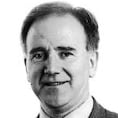"There was a man sent from God, and whose name was Jim," wrote Sean O'Casey of Jim Larkin. Those who knew this other `Big Fellow', as he too was known, tended to think of him in such terms. They saw him as a Liverpudlian gift to the Irish working class, in particular to the working class of Dublin. As such he was celebrated by poets, dramatists, and writers.
"His name endures on our holiest page/ scrawled in a rage by Dublin's poor," wrote Austin Clarke. "The greatest Irishman since Parnell," said George Bernard Shaw.
Plays have been written about him by Daniel Corkery, Donagh McDonagh, James Plunkett, Sean O'Casey, Eoghan Harris, AE (George Russell). He inspired poetry by Frank O'Connor, Patrick Kavanagh, Brendan Behan and Austin Clarke, paintings by Sir William Orpen and Sean Keating, and sculptures by Sukov and Carney.
Born in Liverpool
Big Jim was born in Liverpool on January 28th 1874, the second eldest of six children. Both his parents were from Co Down. Probably because of his size, he found work on Liverpool docks, where he was a foreman, earning £3.10s when he married Elizabeth Brown in 1903. Larkin became national organiser of the National Union of Dock Labourers and it was in that capacity that he made his first trip to Ireland, arriving in Belfast on January 20th, 1920. A strike for better conditions was organised at the Gallaher tobacco company. Larkin had pamplets distributed advising people that "the way to stop tyranny is to smoke only tobacco manufactured by . . ." - listing the other Irish tobacco companies. Gallaher's imported blackleg labour to replace their striking workers. A policeman was suspended for refusing to sit beside a black-leg driver accompanying Gallaher products through the streets of Belfast. Then the police went on strike. A settlement was reached and Larkin moved on to Dublin. That was in 1908. He found it "something terrifying to see how people lived in the streets and slums of Dublin". The city had a population of 305,000 then, 26,000 of whom lived in 5,000 tenements. Of that number 21,000 lived in one-room flats. The city's two workhouses held a further 6,100 people, where the death rate was 1,600 annually. The death rate among the city's poor generally was 35 per thousand, compared with 20 in Belfast, and its infant mortality rate, at 142 per 1,000, was among the highest in Europe.
It was in this context that Larkin set about unionising Dublin's working class. It was estimated that he succeeded in recruiting over 70,000 of the city's workers into the union, which had its mightiest confrontation with employers in the 1913 Lockout. Inspired by his fiery oratory and passionate commitment to improving the lot of the people, Dublin's poor responded as never before.". . .The miracle had taken place. Larkin had led the Dublin working class out of the pit, out of obscurity," wrote James Connolly later.
Irish Citizen Army
In response to police attacks on protesters at a rally in the city on August 31st 1913, when a number of people were killed, Larkin decided to take the advice Edward Carson had given the unionist people in the North the previous year, and called on his fellow workers to arm themselves. The Irish Citizen Army, said to be "the first Red Army in modern Europe", was set up in November 1913. Sean O'Casey, the its honorary secretary, described Larkin as "the soul of the Irish Citizen Army". Meanwhile, the Catholic Church was denouncing Larkin all over the archdiocese of Dublin, as was the Ancient Order of Hibernians. He was, they said, an agent of Godless socialism, and no respecter of the rights of property. "But Larkin raged on," wrote Gabriel Fallon, "declaring that he spoke and acted in the spirit of the Beatitudes."
Also in 1913, Larkin and his family were evicted from their home at Auburn Street in Dublin. The following year, he made his first trip to the US to raise funds for the union. While there, he gave the oration at the funeral of the great trade union organiser Joe Hill, who had been excecuted at Utah state prison. He was arrested and tried following anti-conscription speeches in New York, serving in Sing Sing from 1920 to 1923. There he was visited by the comedian Charlie Chaplin, with his friend, the writer Frank Harris.
Croke Park rally
There was a big rally in Croke Park for Larkin on his return to Dublin, and he pleaded passionately for an end to the Civil War. However, a split was looming within the IT&GWU, which resulted in him setting up the Workers' Union of Ireland in 1924. The split continued to 1959. He was general secretary of the WUI until his death in 1947. After 1924 his life settled into a sort of normality, as he became active in Dublin city politics, where he was a councillor for many years before his death. He was elected a TD in 1927, 1937, and 1943.
His funeral to Glasnevin, on a bleak January day at the time of "the big snow", was attended by thousands of Dubliners. "He was myself! And every mother's son of us! Ourselves," wrote that son of working-class Dublin, Brendan Behan.
